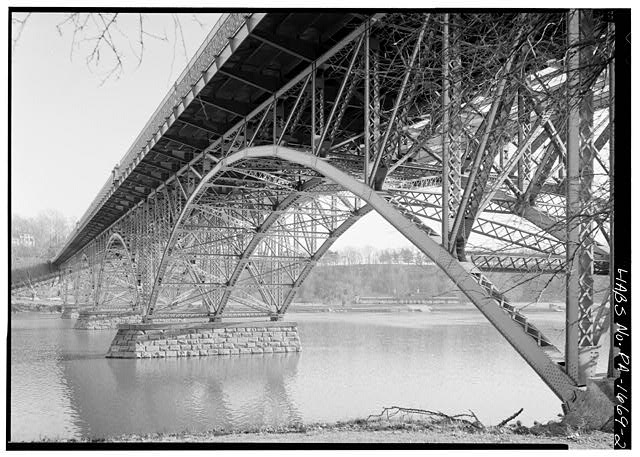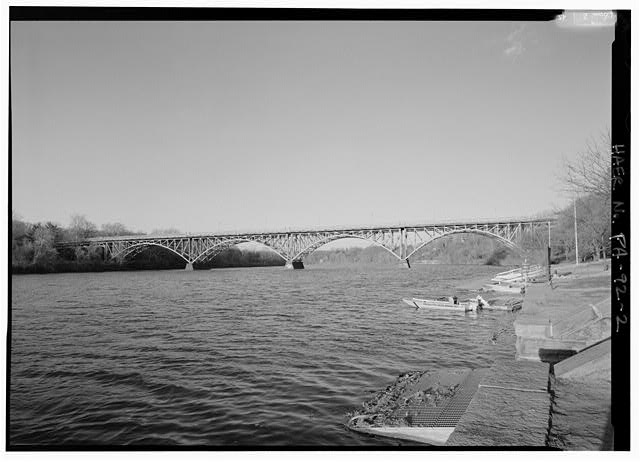
"Oblique view of four wrought iron arches with stone masonry piers." HAER
Strawberry Mansion Bridge, 1896-97
Schuylkill River at Ford Drive and Strawberry Mansion Drive, Philadelphia PA
© Jane Mork Gibson,
Workshop of the
World (Oliver Evans Press, 1990).
Because it was originally a
"trolley bridge," the history of the Strawberry Mansion
Bridge is irrevocably tied to that of the Fairmount Park
Transportation Company which for fifty
years—November 10, 1896 to November 10,
1946—operated a street railway line that extended
for 8.8 miles and ran wholly within the boundaries of
Fairmount Park. 1
The trolley
bridge over the Schuylkill River connected the East Park
where one terminal was located at 33rd and Dauphin in the
Strawberry Mansion District, to the West Park where the
other terminal was at 44th and Parkside. There had long
been sentiment for construction of a bridge over the
Schuylkill between the Girard Avenue Bridge and Falls
Bridge that would carry general traffic, and the
Strawberry Mansion Bridge met this need by providing
space for pedestrians and carriages as well as for the
trolleys.
The promoter and director of the street railway project
was Charles H. Porter, a Philadelphia Republican
politician. A New Jersey Charter was issued to the
corporation November 10, 1894 with the stipulation that
the line be in operation within two years. The
Fairmount Park Commission granted a franchise, assessing
a two percent levy on gross receipts which continued
throughout the line's operation. Construction on the
piers and abutments of the bridge started in July, 1896.
There was a controversy over who would get the
contract—the Phoenix Bridge Company or the Pencoyd
Iron Works—both located on the Schuylkill River
upstream, and both aware of the politics involved.
The bridge consists of "four wrought-iron arches on three
stonemasonry piers with three Warren trusses supporting
viaducts on east and west approaches…Russell Fair,
Jr., engineer; Theodore Cooper, consulting engineer;
Phoenix Bridge Co., builders." 2
Although the
company was able to meet its commitment by officially
opening on November 10, 1896, and running cars in the
West Park until the end of that month, Strawberry Mansion
Bridge was not completed until April 20, 1897, and it was
opened to trolley traffic on June 13, 1897. It also had a
40 ft. carriageway and a 12 ft. pedestrian sidewalk. The
bridge was not changed or altered in any way before the
line was shut down in 1946.
The bridge itself was a
source of much interest in traction circles at the time
of its construction, it being one of the largest such
projects undertaken in the United States up until that
time. The bridge, still in use by highway traffic today,
is 1237 feet long and 790 feet wide. Since it was built
primarily for the use of the trolley company the trolley
had a double-track private right of way along the south
side of the bridge, separated by a railing from the
remainder of the bridge which was for pedestrian and
vehicular traffic. The carriageway is 40 feet wide.
The bridge consists of one lattice-girder span forty feet
long and two lattice-girder spans seventy feet long which
make up the approaches on the west bank. Four steel spans
each 208 feet long span the river and the east-bank
approaches use two lattice-girder spans each seventy feet
long and one 85 feet long. The carriageway is paved with
asphalt. The trestle for the trolley line was much more
than substantial than usual because of the prevalence of
open cars on the line and the consequent safety problems
involved. The ties ran the full width of the roadway
under both tracks and the area was planked with 26 inch
yellow-pine planking between and on the sides of the
tracks. A guard rail ran the full length of the bridge on
the river side of the trolley roadway. This right of way
is still there, unused. 3

Looking
north. HAER
The trolley line was a single track that operated in one
direction, with parallel tracks for only a short
distance. It carried passengers to parts of the park that
were wooded and quite unaccessible at the time of the
Centennial. The trolley had a summer route that consisted
of two loops, and both stopped at Woodside Park, an
amusement park built and operated by the trolley company
about halfway around each loop. It was necessary to
transfer to go from one terminal to the other in summer,
but in winter there was only a single loop.
The line operated at a profit only so long as it was
utilized by the public for access to recreation and
entertainment, for it could rely on commuter traffic for
only a small portion of its revenue. In 1917 the company
was purchased by the Fairmount Park Transit Company at a
receiver's sale, and the Fairmount Park Commission
transferred the license, retaining the right to 2 percent
of gross revenue. Business prospered in the early 1920s,
peaking at 2,000,000 passengers a year, but then a
decline began.
Strawberry Mansion Bridge by 1927 was showing signs that
repairs should be undertaken. In his Annual Report for
that year the Chief Engineer of Fairmount Park wrote,
The
trolley bridge is continuing to deteriorate. The asphalt
roadway which was laid on cinder concrete is wearing out
and the floor plates are corroding. The whole structure
below the road level needs painting and all laminated
floor beams should be replaced. 4
By 1933 the situation was so bad the Park Commissioners
demanded that repairs be made, but the company was unable
to comply. In 1939, when its operating license expired,
the company gave ownership of the bridge to Philadelphia
in return for a ten-year renewal. The city then undertook
repairs to the structure.
The public's love affair with the automobile, and the
aging of the original rolling stock, which was then fifty
years old, caused the company to file for permission to
abandon in 1946, and the assets were sold at public
auction November 6, 1946. On the previous September 10
the Route 85 bus had already taken over, carrying
passengers from the Dauphin Station to the Parkside
Station, but traveling over streets outside the park and
crossing the river at City Line. The tracks on Strawberry
Mansion Bridge were auctioned off along with the other
trackage, and the bridge entered into its present-day
status, carrying all types of traffic except trolleys.
1 See also
Workshop
of the World "Fairmount Park Transportation Company
Power Station."
2 Richard
Webster, Philadelphia
Preserved, (Philadelphia, 1976), p.
240.
3 Harold E. Cox,
The
Fairmount Park Trolley, A Unique Philadelphia
Experiment, (Printed by Harold E. Cox,
80 Virginia Terrace, Forty Fort, PA 19704, 1970), p. 11.
4 Fairmount Park
Commission, "Annual
Report of the Chief Engineer," (1927), p. 3.
Update May
2007 (by
Jane Mork Gibson):
The Strawberry Mansion Bridge stopped being used for
trolleys after 1946, yet it continued to be a link
between East and West Fairmount Park, serving
pedestrians, vehicles, horses, and bicycles. In 1996 the
bridge was closed, being declared unsafe because of
severe deterioration of the road deck, footways, steel
arches, and deck truss spans. Owned by the City of
Philadelphia and an important part of its history, the
Streets Department undertook restoration of the bridge,
including historic elements to recreate its original
appearance. The work was done in phases, with the bridge
opened to vehicular and pedestrian traffic in 1999. A
pedestrian promenade, a new element, and other ornamental
details were added later. The bridge was cleaned and
repainted in its original dark olive green color. The
public was invited to the official opening on June 29,
2001, when a celebration was held at the bridge and the
ladies received colorful parasols and the men straw
boater hats.
The Strawberry Mansion Bridge Restoration was nominated
for and won the 2002 Preservation Achievement Award,
given by the Preservation Alliance for Greater
Philadelphia, cited as “an outstanding restoration
and renovation of a historic public asset." Following is
a description given in the nomination by Fairmount Park:
One
of the project’s greatest achievements was the
adaptive reuse of the old trolley lanes as a pedestrian
promenade. This section of the bridge had not been used
since the end of trolley service in 1946. The new
promenade, which measures 27 feet by 800 feet, extends
the length of the bridge.... Viewing wells in the deck
allow pedestrians to view scullers in the river below as
well as the intricate truss system located just below the
deck. The promenade also features two new sections of
trolley track along with reproduction and original
trolley catenary poles. The track sections, along with
interpretive signage, help visitors understand the
history of the Strawberry Mansion Bridge and Fairmount
Park.
See also:
Historic American Engineering Record -
Strawberry Mansion Bridge, Ford Road & East River
Drive
Historic American Engineering Record -
Strawberry Mansion Bridge, Spanning Schuylkill River
at Strawberry Drive